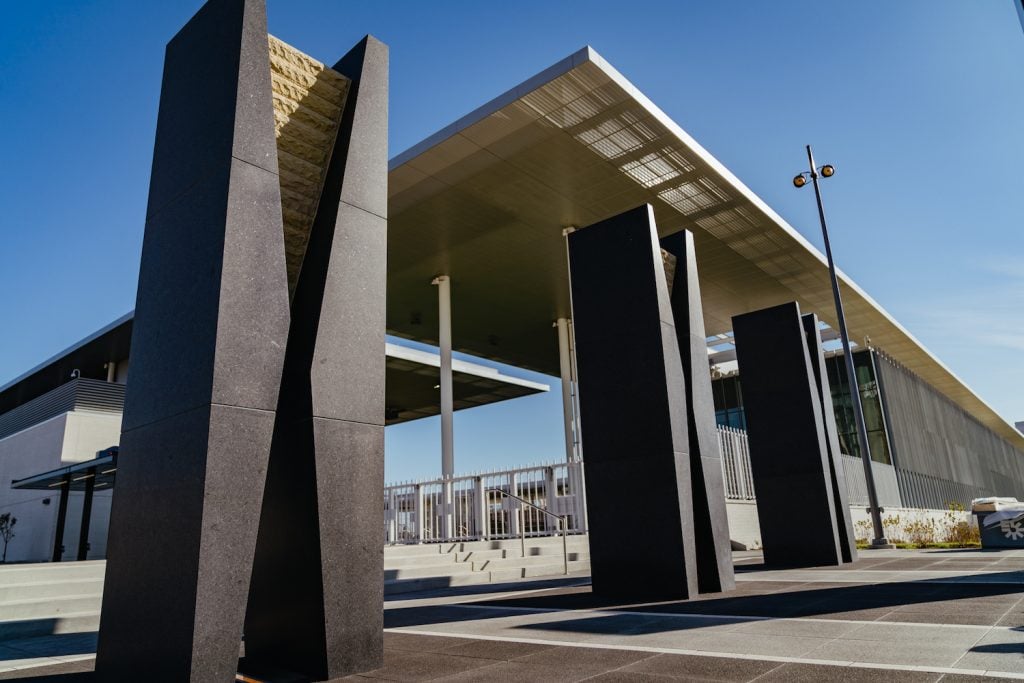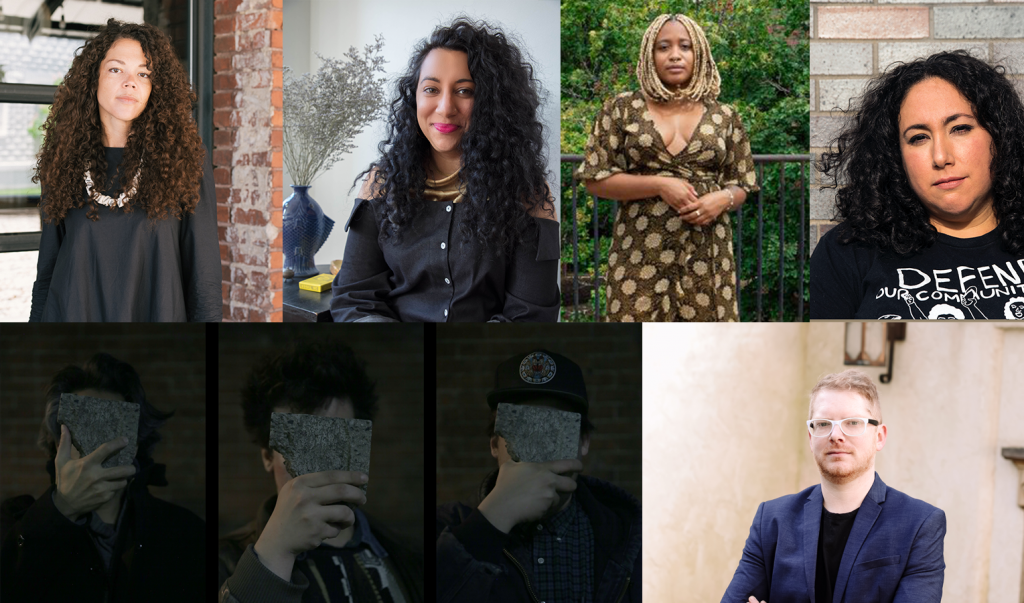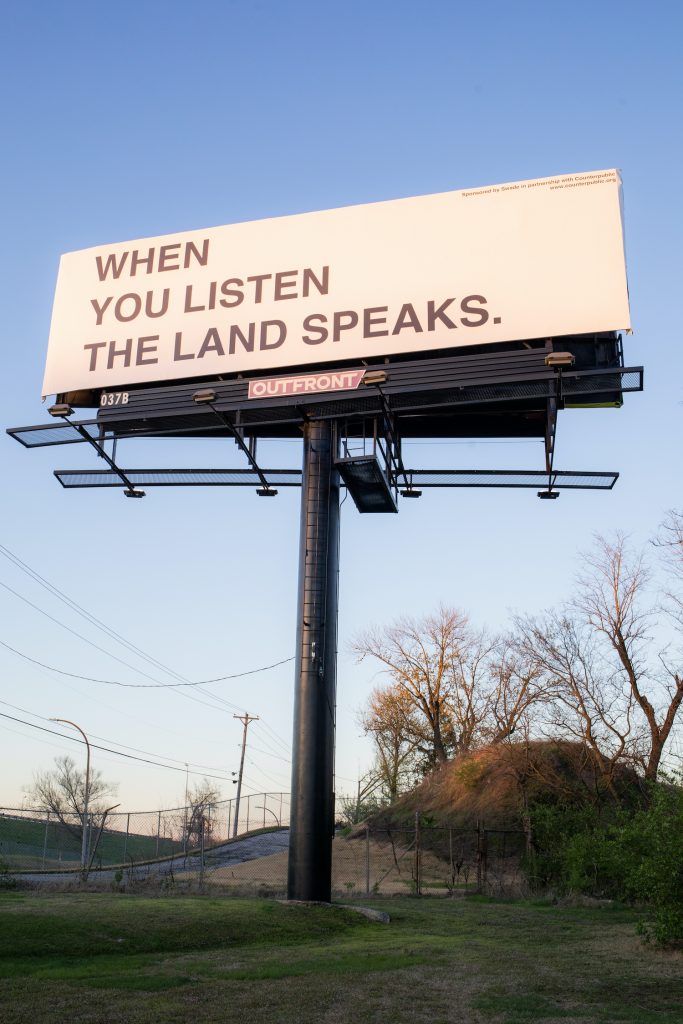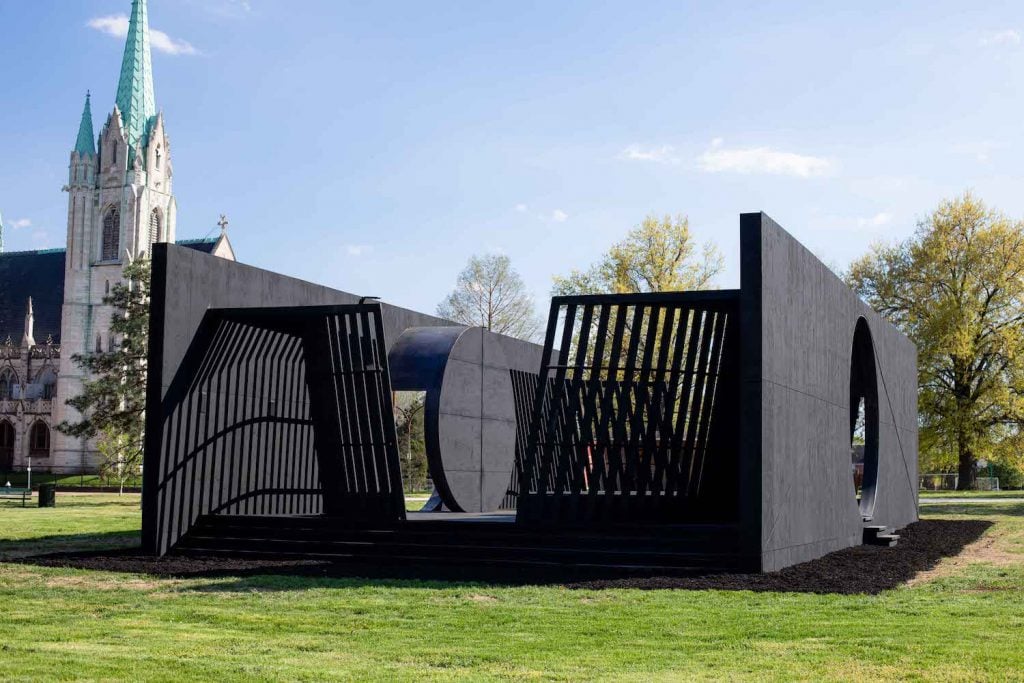On View
Counterpublic’s 2023 Exhibition in St. Louis Shakes Up the Formulaic—and Often Problematic—Shape of American Triennials
Projects by David Adjaye, Raven Chacon, and Torkwase Dyson highlight this year’s exhibition.

Projects by David Adjaye, Raven Chacon, and Torkwase Dyson highlight this year’s exhibition.

Taylor Dafoe

“What is needed now, and what is needed next?”
This is one of the prompts offered by James McAnally, the founder and director of St. Louis’s recurring Counterpublic exhibition, in an op-ed published on this site in 2021. On McAnally’s mind at the time was the function of bi- and triennial art events like his, and how they might better realize the kind of meaningful communal impact to which they so often aspire. The second Counterpublic, he promised, would be a “singular civic platform meant to reimagine how art engages the contexts, textures, and futures of St. Louis.”
Fast forward two years and Counterpublic 2023 is now open. It unfolds across 25 locations situated along a six-mile stretch of Jefferson Avenue—a street that spans numerous neighborhoods and socioeconomic spaces. As an orientative form, it also subverts St. Louis’s status as the “Gateway to the West”: a portal through which settlers once passed in the name of manifest destiny. “These neighborhoods are microcosms of the nation in so many ways,” McAnally said upon announcing the show last year. “They are truly dynamic and resistant to one another. They’re not a single experience.”
The exhibition doesn’t offer a single experience either. For this year’s edition, McAnally’s brought on what he calls an “ensemble” of young curators—Allison Glenn, Risa Puleo, Katherine Simóne Reynolds, Diya Vij, and the artistic collective New Red Order—who were each tasked with organizing site-specific projects along the show’s route. Collectively, the group represents a range of academic interests and curatorial impulses. Those impulses don’t always align.
As such, this year’s Counterpublic is an exhibition of fascinating contradictions. They give the show its thrust. At stake here, against the backdrop of the heartland and its history of industrial capitalism and land dispossession, is a broader consideration not just of how we can use art to incur change, but whether or not art can incur change at all.

The curatorial ensemble for Counterpublic 2023. Clockwise from left: Allison Glenn, courtesy of Rana Young; Diya Vij; Katherine Reynolds; Risa Puleo, courtesy of Gonzalo Reyes Rodriguez; James McAnally; New Red Order.
Launched in 2019, Counterpublic arrived amidst a group of similarly shaped bi- and triennials established in middle-American cities over the last 15 years—Open Spaces in Kansas City and FotoFocus in Cincinnati among them. At the core of many of these events is a similar mission: to revitalize a once prosperous American city through art. (Also at their core: regional philanthropists funding that mission.)
The scope of these shows tends to be both local and national, though they’re often criticized for a lopsided emphasis on the latter. It’s a fair question to ask, why exhibitions like these are so often organized by people who don’t live in the city they seek to transform. Even the cyclical exhibition format itself seems too episodic to provoke meaningful change. Cynics might see the whole exercise as a form of soft cultural imperialism.
But to draw comparisons between this recurring exhibition and other events like it requires one to paint with broad strokes, and Counterpublic doesn’t do broad strokes. The name “Counterpublic,” McAnally explained, suggests multiple different civic groups that are collectively defined only by their opposition to the dominant culture. Recurring art events, like the cities and neighborhoods they occupy, require micro, not macro, engagement.
Counterpublic takes place every three years, but its organizers don’t call it a triennial. (This year’s exhibition was delayed a year because of the pandemic.) Instead, they refer to it as a “civic exhibition” that aims to “reimagine civic infrastructures towards generational change.”
The repetition of the word “civic” makes the point clear: this is a show that strives to reflect its home city. “I think a lot of times events like this have a very sort of abstract relationship to audience. They seem designed for the art world. They seem designed to get external attention,” McAnally said. “We are doing this for our neighbors first. If we can get it right for our neighbors, we believe we can get it right for the art world.”

Anna Tsouhlarakis, The Native Guide Project: STL (2023). Photo: Chris Bauer. Courtesy of Counterpublic.
Back in 2021, McAnally’s team arranged meetings with community members and partnering organizations to hear what they hoped the next edition of Counterpublic would accomplish. What the locals wanted, McAnally recalled, was for homegrown stories to be told “in public” and “in a durational way.” The Osage Nation, a tribe displaced by St. Louis’s founding European colonizers, expressed a desire for visibility.
At the same time, Counterpublic’s curators were wrestling with St. Louis’s own history of displacement. Puleo endeavored to “make erasure visible” and present work that didn’t “occupy.” She and others sought to resist typical biennial fare, particularly large-scale public sculptures and monuments. Puleo said they wanted to avoid work that “just goes plop.”
In other words, at the core of Counterpublic 2023 is a series of seemingly competing aims: visibility, but not occupation; durationality, but not permanence; accessibility, but with a rigorous historical consciousness. How the curators operated within this framework varied significantly; so did the projects they organized.
Vij helped virgil b/g taylor produce a series of zines (“Confluence Decree”) about St. Louis’s sewer system, and worked with Steffani Jemison, who created an installation and sound piece that were inspired by Josephine Baker, the first Black woman to star in a major motion picture. Reynolds, meanwhile, tapped the choreographer Will Rawls to create a stop motion film with four channels, each of which is screened at different Jefferson-adjacent sites. One is at a McDonald’s; another is at a costume store called Johnnie Brock’s Dungeon Party Warehouse.
McAnally also curated several projects, most notably an immersive architectural and sonic installation by Torkwase Dyson. The work, which covers hundreds of square feet in St. Louis Place Park, takes the form of a constructed amphitheater, replete with benches, stools, and various apertures that reframe the surrounding neighborhood. From several embedded speakers plays a recording that mixes the music of ragtime pioneer—and St. Louis transplant—Scott Joplin with Dyson’s own interpretation of his signature mashup of classical piano and African polyrhythms. According to Counterpublic’s catalogue, Dyson wanted “to make direct correlations between syncopation and the body to explore the spatial impact of present-day climate migrations, displacement, and nomadicity.”
Dyson’s work, called Bird and Lava (Scott Joplin), is huge, but not immutable. The structure’s modularity encourages different configurations and the whole thing is put together without nails or screws, making it adaptable to different environments. It’s a real achievement—the work of an artist in full control of her own visual language.

Torkwase Dyson, Bird and Lava (Scott Joplin), 2023. Photo: Chris Bauer. Courtesy of Counterpublic.
Puleo, for her part, opted to pursue presentations that were subtle, ephemeral, and—in some cases—completely invisible. Among the projects organized by the curator are a reimagined state map painted by Jaune Quick-to-See Smith; an augmented reality piece by Cannupa Hanska Luger; and a performance by the Pulitzer Prize-winning composer Ravon Chacon that subdivides the twelve-note Western musical scale into 13 divisions.
Puleo worked near, but not on, Sugarloaf Mound, the last intact Native American mound and the oldest human-made structure in St. Louis. Upon joining Counterpublic 2023, the curator wrote to the Osage Nation, which owns the mound, asking permission to include it in the show. She and New Red Order are also working to have the rest of the mound’s land repatriated to the tribe. Looming over the site is a billboard that reads, in no uncertain terms: “Got land? Give it back!”
Puleo also assisted artist jackie sumell in repatriating centuries-old bricks that were produced in St. Louis, then later extracted from Black communities and sold downriver to build plantation-revival-style homes in New Orleans. “Think about all of the enslaved, fugitive people who made their way up to St. Louis, established a thriving black community in the early part of the century, then were systematically disenfranchised,” said Puleo. “Literally, the bricks from their houses were sold… along the same pathways through which they escaped confinement.”
sumell buried the bricks somewhere in St. Louis, but she won’t reveal where. “It might not be seen, but I hope that it is felt,” Puleo said of the work.

New Red Order, Give it Back: Stage Theory (2023). Courtesy of Counterpublic.
If Sugarloaf Mound represents one end of Counterpublic, the neighborhood of St. Louis Place represents the other. Located there is the Griot Museum of Black History, a cultural venue that bears little resemblance to those of the institutional art world. Dusty and drab (albeit charmingly so), the museum charts a subjective history of Black life in America, its many installations centered around life-sized wax figures of people like Miles Davis, Elizabeth Keckley, and Dred and Harriet Scott.
The Griot will also soon be the site of something else: the first public artwork by David Adjaye. In the museum’s courtyard, the architect-cum-artist is working to erect a version of his “Asaase” series of sculptures, made up of curved, overlapping barriers inspired by the earth-based architecture of West Africa. Built from rammed earth, Adjaye’s work is big and physical; it will outlast anyone alive to see it made. Compared to Counterpublic’s other, more transitory projects, the sculpture is conventional in its material approach. But the power of the piece also comes through its permanence.
Well, not all its power. More than his sculpture, what Adjaye has really given the Griot is his name. For the museum, a modest cultural destination that few outside of St. Louis have ever heard of, the association will have a truly transformative effect. For the museum, this is art that is needed now and next.
That fact wasn’t lost on Adjaye. “It’s a device,” he said of his sculpture during Counterpublic’s opening weekend. He was speaking with Glenn in a panel discussion held in the Griot’s stuffed, carpeted basement. (The building used to be an elementary school, and it shows.) “It’s a trojan horse to invite you to come and be here and engage with this community and engage with this place.”
Counterpublic 2023 is on view in St. Louis through July 15.